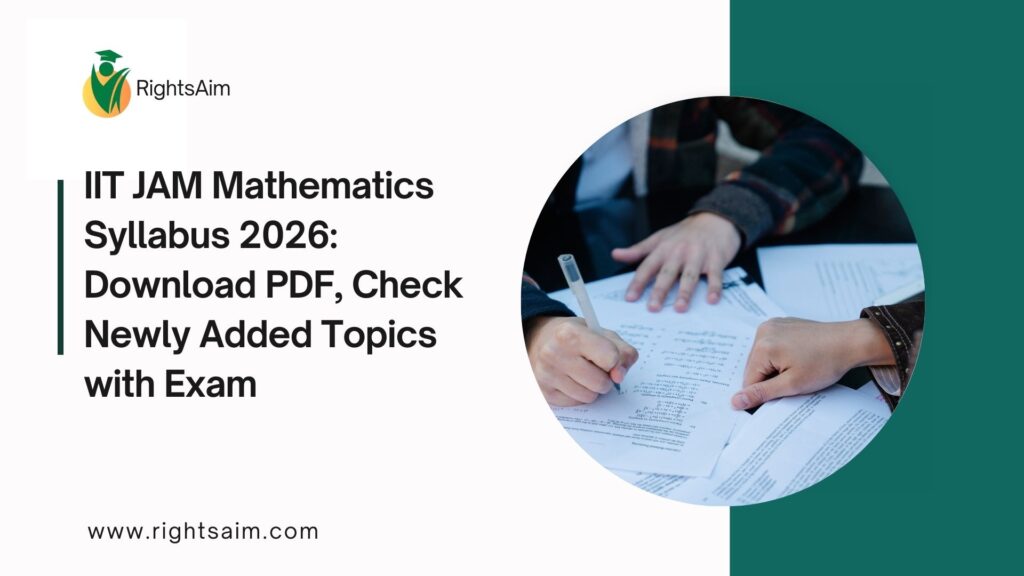The IIT Joint Admission Test for Masters (IIT JAM) 2026 is one of the most competitive exams for students aspiring to pursue postgraduate programs in Mathematics and related fields. If you’re preparing for the Mathematics (MA) paper, understanding the official syllabus and exam pattern is the first step to success.

Table of Contents
IIT JAM Mathematics (MA) Syllabus 2026
Official PDF Download
You can access the official IIT JAM Mathematics syllabus PDF directly from the IIT JAM 2026 site:Subject-Wise Syllabus Overview
The syllabus is divided into several core areas, each designed to test your graduate-level math skills.
1. Real Analysis
Sequences & Series: convergence, bounded/monotone sequences, Cauchy sequences, Bolzano–Weierstrass theorem
Absolute convergence, tests (comparison, ratio, root, Leibniz), power series, differentiation/integration term-wise
Functions of one real variable: limit, continuity, intermediate value property, differentiation, Rolle’s and Mean Value Theorems, L’Hôpital’s rule, Taylor’s theorem, maxima/minima
Riemann integration and the Fundamental Theorem of Calculus
2. Multivariable Calculus & Differential Equations
Functions of two/three variables: limits, continuity, partial derivatives, total derivative, maxima/minima
Integral Calculus: double/triple integrals, change of integration order, computing surface area & volume
Differential Equations: Bernoulli’s equation, exact equations, integrating factors, orthogonal trajectories, homogeneous equations, separation of variables, Cauchy–Euler, variation of parameters
3. Linear Algebra & Abstract Algebra
Matrices and Systems of Equations: rank, nullity, rank-nullity theorem, inverse, determinants, eigenvalues/eigenvectors
Vector Spaces: linear independence, basis, dimension, linear transformations, range and null space, matrix representation
Group Theory: cyclic groups, abelian/non-abelian groups, permutation groups, normal subgroups, quotient groups, homomorphisms, Lagrange’s theorem
4. Additional Topics (Optional but Worth Covering)
Complex Analysis & Topology (mentioned in some sources)
Exam Pattern for IIT JAM Mathematics 2026
The IIT JAM Exam for all subjects (including Mathematics) follows this structure:
Mode: Online (Computer-Based Test)
Duration: 3 hours
Total Questions: 60 questions, totaling 100 marks
Sections:
Section A: 30 Multiple Choice Questions (MCQs) — includes 1-mark and 2-mark questions; negative marking applies
Section B: 10 Multiple Select Questions (MSQs) — all options must be correct to earn marks; no negative marking
Section C: 20 Numerical Answer Type (NAT) questions — answer entered manually; no negative marking
New Additions This Year
While the core syllabus remains largely unchanged, a few fresh topics now appear in the 2026 syllabus overview:
Vector Calculus / Metric Spaces / Complex Analysis
Topology basics have been noted by broader sources.
These may not be emphasized in all resources, so be sure to cross-check against the official PDF.
Topic-Wise Weightage Insights
A breakdown of topic-wise weightage based on recent analysis:
| Topic | Estimated Weightage |
|---|---|
| Differential Calculus | 23% |
| Real Analysis | 21% |
| Single Variable Calculus | 18% |
| Linear Algebra | 14% |
| Multivariable Calculus | 14% |
| Vector Calculus | 12% |
| Differential Equations | 11% |
| Abstract Algebra | 10% |
How to Prepare Effectively
Download & Bookmark the Official Syllabus PDF for constant reference.
Segment your study plan by topic – start with high-weight areas: Calculus, Real Analysis, Linear Algebra.
Practice previous IIT JAM papers, especially focusing on Section B (MSQs) and Section C (NAT) formats.
Integrate the new topics like Vector Calculus or Complex Analysis from reliable sources.
Time yourself when solving mock papers to simulate exam conditions.
Review conceptual gaps and solidify fundamentals—especially in core areas.
